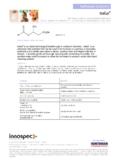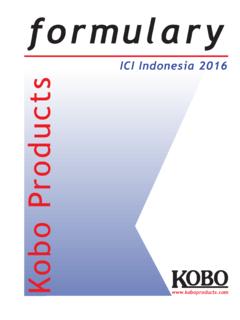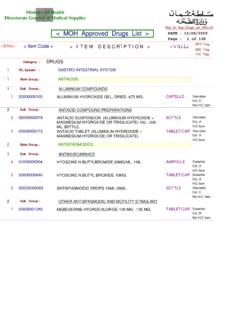Transcription of Section 2 - Hazards Identification
1 Safety Data SheetSection 1 - IdentificationProduct Name: K-Chem Panel Brite (DG05D5) Emergency Phone: 800-255-3924K-Chem, Box 530632 Birmingham, AL 35253-0632205-592-0844 Product Use: Industry Standard Transportation CleanerSection 2 - Hazards IdentificationGHS Ratings:Skin corrosive1 ADestruction of dermal tissue: Exposure < 3 min. Observation < 1 hour, visible necrosis in at least one animalEye corrosive1 Serious eye damage: Irreversible damage 21 days after exposure, Draize score: Corneal opacity >= 3.
2 Iritis > evidence of human or animal carcinogenicityGHS HazardsH314 Causes severe skin burns and eye damageH318 Causes serious eye damageH351 Suspected of causing cancerGHS PrecautionsP201 Obtain special instructions before useP202Do not handle until all safety precautions have been read and understoodP260Do not breathe dust/fume/gas/mist/vapours/sprayP264 Wash hands thoroughly after handlingP280 Wear protective gloves/protective clothing/eye protection/face protectionP281 Use personal protective equipment as requiredP310 Immediately call a POISON CENTER or doctor/physician if you feel unwell after exposure of this treatment (see First Aid below or label)P363 Wash contaminated clothing before reuseP301+P330+P331IF SWALLOWED: Call a POISON CENTER or doctor/physician.
3 Rinse mouth. Do NOT induce vomitingP303+P361+P353IF ON SKIN (or hair): Remove/Take off immediately all contaminated clothing. Rinse skin with water/showerP304+P340IF INHALED: Remove victim to fresh air and keep at rest in a position comfortable for breathingP305+P351+P338IF IN EYES: Rinse continuously with water for several minutes. Remove contact lenses if present and easy to do continue rinsingP308+P313IF exposed or concerned: Get medical advice/attentionP405 Store locked upP501 Dispose of contents/container in conformance with State, Local, and Federal Word: DangerSDS for: K-Chem Panel Brite (DG05D5)Page 1 of 6 Printed: 7/23/2015 at 1:25.
4 38 PMSection 3 - Composition, Information on IngredientsChemical Name CAS numberWeight Concentration %N,N-bis(Carboxymethyl)-glycine, trisodium - - , - acid, tetrasodium salt, - acid and salt - 4 - First Aid MeasuresINHALATION: If inhalation of mists, vapors, or spray occurs and adverse effects result, remove to uncontaminated area. Evaluate ABC's (is Airway constricted, is Breathing occurring, and is blood Circulating) and treat symptomatically. GET MEDICAL ATTENTION IMMEDIATELY. There is no specific antidote, treat CONTACT: Immediately flush contaminated eyes with a directed stream of water for as long as possible.
5 Remove contact lenses, if present and easy to do. Continue rinsing. GET MEDICAL ATTENTION IMMEDIATELY. Washing eyes within several seconds is essential to achieve maximum effectiveness. SKIN CONTACT: Immediately flush contaminated areas with water. Remove contaminated clothing, jewelry, and shoes immediately. Wash contaminated areas with large amounts of water. GET MEDICAL ATTENTION IMMEDIATELY. Thoroughly clean and dry contaminated clothing before reuse. Discard contaminated leather goods. INGESTION: If swallowed, do not induce vomiting.
6 For definite or probable ingestion, do not administer oral fluids. If vomiting occurs spontaneously, keep airway clear. Monitor airway. Volume resuscitation (IV fluids) and circulatory support (CPR) may be required. Never give anything by mouth to an unconscious or convulsive person. GET MEDICAL ATTENTION to Physician: Medical observation and assessment is recommended for all ingestions, all eye exposures, and symptomatic inhalation and dermal exposures. For symptomatic ingestion, do not administer oral fluids and consider investigation by endoscopy, X-ray, or CT scan.
7 Esophageal perforation, airway compromise, hypotension, and shock are possible. For prolonged exposures and significant exposures, consider delayed injury to exposed tissues. There is no antidote. Treatment is supportive care. Follow normal parameters for airway, breathing, and circulation. Surgical intervention may be 5 - Fire Fighting MeasuresFlash Point: N/ALEL: UEL: Fire Hazard: Negligible fire point: Not flammableExtinguishing Media: Use extinguishing agents appropriate for surrounding to Mechanical Impact: Not sensitive.
8 Sensitivity to Static Discharge: Not sensitive. GHS:Physical Hazards : - Corrosive to MetalsHazardous Decomposition:Toxic Vapors of Sodium OxideSDS for: K-Chem Panel Brite (DG05D5)Page 2 of 6 Printed: 7/23/2015 at 1:25:39 PMFire Fighting: Move container from fire area if it can be done without risk. Cool containers with water. Avoid contact with not apply water directly on this product. Heat is generated when mixed with water. Wear NIOSH approved positive-pressure self-contained breathing apparatus operated in pressure demand mode.
9 Section 6 - Accidental Release MeasuresPersonal Precautions: Do not get in eyes, on skin or on clothing. Avoid breathing mist, vapor, or spray. Do not ingest. Wear appropriate personal protective equipment recommended in Section 8 of the SDS. Methods and Materials for Containment and Cleaning Up: In case of spill or leak, stop the leak as soon as possible, if safe to do so. Completely contain spilled materials with dikes, sandbags, etc. Shovel dry material into suitable container. Liquid material may be removed with a vacuum truck.
10 Remaining material may be diluted with water and neutralized with dilute acid, then absorbed and collected. Flush spill area with water, if appropriate. Environmental Precautions: Keep out of water supplies and sewers. Do not flush into surface water or sanitary sewer system. This material is alkaline and may raise the pH of surface waters with low buffering capacity. Releases should be reported, if required, to appropriate 7 - Handling & StorageHandling Procedures: Avoid breathing vapor or mist. Do not get in eyes, on skin, or on clothing.






